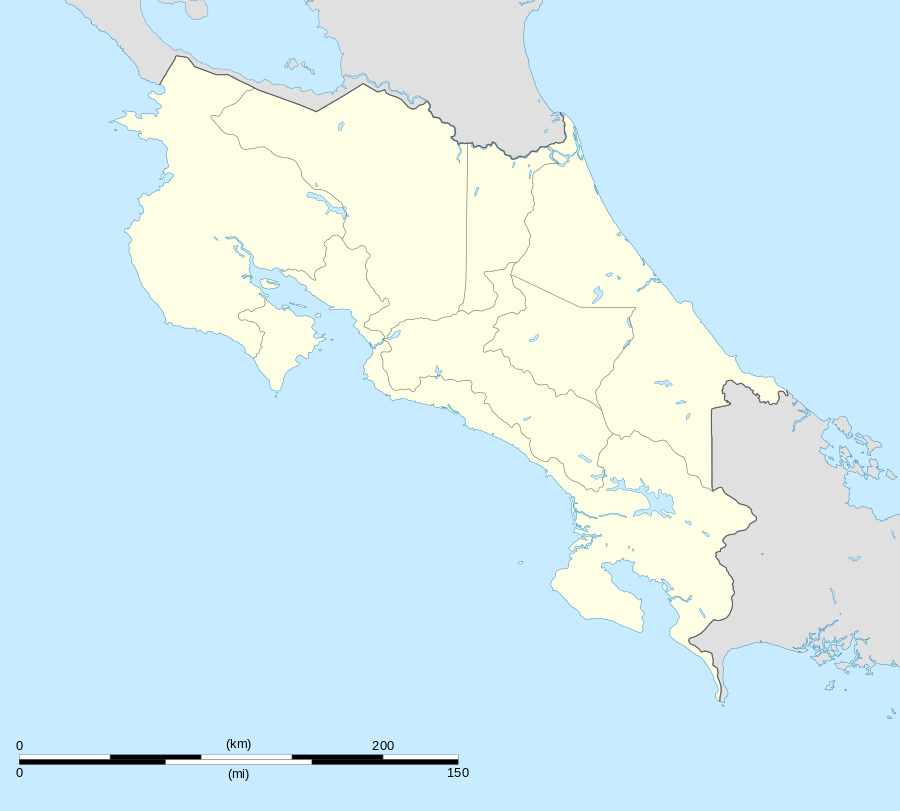Sierra, Abangares
| Sierra | ||
|---|---|---|
| District and village | ||
| ||
 Sierra Location in Costa Rica | ||
| Coordinates: 10°17′11″N 84°55′47″W / 10.28639°N 84.92972°W | ||
| Country | Costa Rica | |
| Province | Guanacaste | |
| Abangares | Abangares | |
| Government | ||
| • Syndic | Álvaro Antonio Espinoza Chaves (PLN) | |
| • Substitute syndic | Olga Alicia Montero Chavarría | |
| Area | ||
| • Total | 141.47 km2 (54.62 sq mi) | |
| Population (2013) | ||
| • Total | 2,589 | |
| • Density | 18/km2 (47/sq mi) | |
| Time zone | CST (UTC-6) | |
| • Summer (DST) | n/a (UTC) | |
| Postal code | 50702 | |
Sierra, ("Las Minas") is a district in Abangares. It is well known as the historical mining town of Costa Rica, located on the NW Pacific Region. It goes from an altitude of 210 meters to 1200 meters.[1] It is a mountainous zone with a variety of temperatures (from 34 °C to 5 °C) and climates (from dry forest to rain forest). To the north it borders Tilarán Canton, to the south San Juan de Abangares and Las Juntas District(SW), to the east Monteverde and to the west it borders Cañas Canton.
History and Mining
Oral history tells that the name of "Sierra" its related to one of the first resources the town took advantage, the wood. The Spanish word "sierra" means "saw". Residents developed sawmills by the time they knew about the valuable and precious woods they got.
Although, by the year 1900 the gold mining industry rose in Abangares but mostly in Sierra, were the Abangares Gold Fields of Costa Rica (Abangares Mining Company) own by Minor C. Keith, built up the Stamp mill House, the Company Headquarters and the Powder House. The ore activity carried vast development. By that time, people compared La Sierra development with California (as well because the Gold rush).
Mining Ecomuseum
The Mining Ecomuseum is located on 38 hectares of local government property and managed by the district Committee of Culture and Management of Museums. It documents and celebrates one of the first mining centers in Central America, and the legends and realities that the miners of the time lived in. The recent built showroom displays graphic and documentary information. Various paths explain the mining infrastructure, which preserves the spirit of the mining years (1901–1931).[2]
The “Ecomuseum” idea arose in France in the 1970s. In Costa Rica it was adopted in the 1980s, when Ecomuseum Mines of Abangares was created. It’s an educational model of culture and sustainable development that integrates inhabitants with rational resource use, and ecological protection and cultural protection.
The Eco-museum was developed around the ruins of one of the oldest gold mines in the region, where old machinery, hand tools, and infrastructure can still be seen. The surrounding area is largely forested and provides opportunities for bird and butterfly watching, and other nature observation. It is a community organization that conserves and transmits local history, and strengthens the identity of the towns. In 2001, it was declared a Historical Architectonic Patrimony.[3]
The Ecomuseum is in an area that holds evidence of the biggest scale of gold mining in Costa Rica, where the Company “Abangares Gold Fields of Costa Rica” operated. It contains an outdoor exhibition of mining machinery, paths that lead to the ruins of an old stamp mill house, “Edificio de los Mazos,” “Casa de la Pólvora,” and great natural scenery. There is a Tunnel on a historical traverse, where Tulita, a steam locomotive, pulled ore wagons. [4]
Economy
The major activities are agriculture (Coffee and variety of Vegetable), Gold mining and Tourism.
Agriculture and mining are the most traditional activities and ways of living in the district. All over the highlands (San Rafael, Cebadilla, Campos de Oro, Cañitas, La Cruz and Tornos) small producers of coffee and vegetables are organized in cooperatives.
The Ecomuseum, the biodiversity, and the hot springs are attracting tourism from all over the world to the district. La Sierra is between Guanacaste and San José, and between Guanacaste and Monteverde.[5] Little by little tourists start stopping on their ways and staying in La Sierra as middle point on their trip and using a non traditional touristic route, to overnight, to make canopy, to visit eco farms, to make historical walks on the Ecomuseum or just to chill on the hot springs.
Villages
Sierra is composed of fifteen villages:[6]
- Aguas Claras
- Alto Cebadilla
- Campos de Oro
- Candelaria
- Cañitas
- Cruz
- Cuesta Yugo
- Dos de Abangares
- La Sierra
- Marsellesa
- San Antonio
- San Rafael
- Tornos
- Tres Amigos
- Turín (part)
References
- ↑ Analisis con enfoque de Agrocadena en Cafe. (PDF). MAG. Retrieved September 24, 2009.
|first1=missing|last1=in Authors list (help) - ↑ Martinez, Ronald. Eco Museo de las Minas de Abangares, Un proyecto que se reconstruye. Museo Nacional de Costa Rica. Retrieved September 24, 2009.
- ↑ Eco Museo de las Minas de Abangares., Ministerio Cultura, Juventud y Deportes, (retrieved September 24, 2009) Check date values in:
|date=(help) - ↑ Segnini Rodríguez, Esteban. Eco Museo Abangares. Pueblo Antiguo Lodge. Retrieved September 24, 2009.
- ↑ Instituto Geográfico Nacional (IGN), 2001.
- ↑ Saborio Valverde, Rodolfo; Diana Coto León. Provincia de Guanacaste, Cantones y Distritos. Organización Administrativa Costarricense. Retrieved September 24, 2009.
External links
- Government and administration
- CCSS District Population, Health Region Abangares.
- Related Articles
- Pueblo Antiguo Lodge Abangares Ecomuseum History.
10°17′00″N 84°55′00″W / 10.283333°N 84.916667°W
